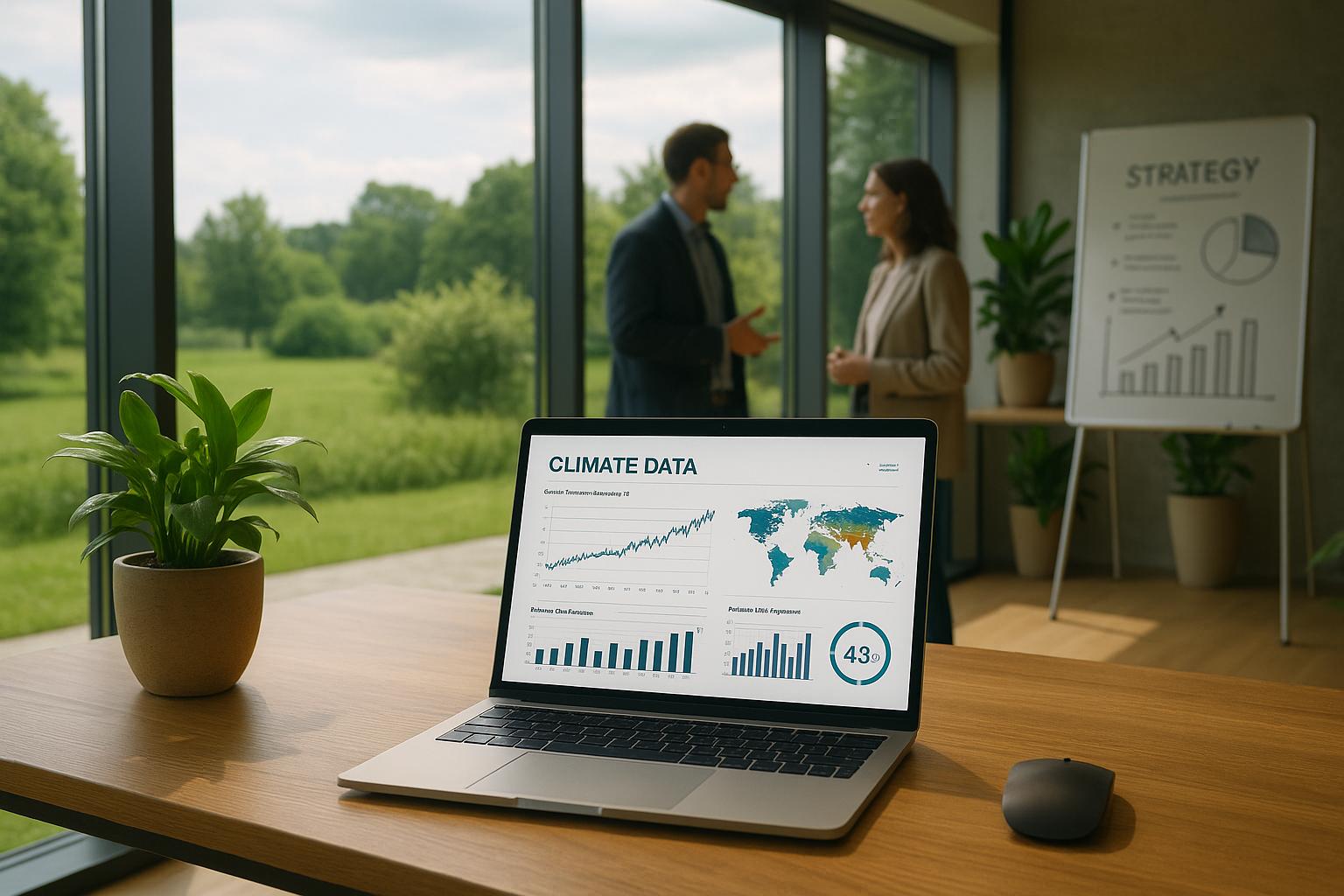Climate Risks and Resilience: Protecting EU Companies from Extreme Weather and Regulatory Challenges
Extreme weather events and climate risks cause billions in damages every year. Companies in the EU...
By: Johannes Fiegenbaum on 7/30/25 8:10 AM

Climate adaptation requires new metrics that go far beyond CO₂ reduction. Companies face the challenge of making the impacts of risks such as extreme weather, biodiversity loss, or supply uncertainties measurable. Traditional KPIs are not sufficient, as they cannot accurately reflect either short-term climate effects or long-term adaptation measures. This gap is increasingly recognized by global organizations and regulators, highlighting the urgent need for more sophisticated and actionable metrics.
Conclusion: Companies must set clear, measurable targets to effectively implement climate adaptation and meet regulatory requirements. This not only ensures compliance but also secures long-term economic stability and competitive advantage as climate risks intensify.
Evaluating adaptation measures presents companies and investors with challenges that go far beyond the difficulties of traditional climate metrics. This complexity stems from the very nature of adaptation and the limited capabilities of current measurement methods. To make progress, the terms resilience and adaptation must first be clearly defined and understood in context.
The unclear definition of resilience and adaptation makes it difficult to formulate concrete goals. Adaptation measures do not necessarily have to explicitly target climate change to be effective. For example, a flood protection facility originally built for purely functional purposes can still make a decisive contribution to climate adaptation.
This uncertainty is compounded by the fact that adaptive measures are often not directly visible when only individual points in time or events are considered. Their effectiveness often only becomes apparent during extreme events, which are rare and difficult to predict.
Moreover, many adaptation strategies only unfold their impact over long periods. Assessing their effectiveness therefore requires observations that extend beyond the duration of individual projects. As the OECD notes: “Measuring adaptation progress is complex and cannot be captured in a single metric.” This complexity also arises from the fact that adaptation involves cross-country and cross-sector efforts that cannot be viewed in isolation.
Once the basic terms are clarified, the full extent of the quantitative challenges becomes clear. According to the OECD, 80% of countries report that it is difficult to prove whether adaptation policies reduce climate impacts in the long term (OECD).
| Category | Limitation | Description |
|---|---|---|
| Data Basis | Lack of data and uncertainty | Incomplete or unreliable data, especially on environmental issues such as climate change |
| Methodology | Discounting long-term impacts | Economic approaches often underestimate long-term environmental and social costs |
| System Boundaries | Limited perspectives | Lack of consideration for upstream, downstream, and cumulative effects |
| Social Dimensions | Insufficient consideration of equity | The distribution of impacts across different social groups is often overlooked |
Assessing the effectiveness of adaptation measures remains one of the greatest challenges. Cause-and-effect relationships between measures and climate impacts are difficult to prove, especially as climate events are influenced by a multitude of factors.
Another problem is the lack of comprehensive data and standardized methods, which often neglect important aspects such as upstream and cumulative effects. While 97% of OECD countries state that their climate risk data supports the development of national adaptation policies, only 40% assess the exposure of people, socioeconomic assets, and ecosystems to climate impacts (OECD).
Systematic reviews also show a lack of empirical research on adaptation. Many studies are case studies lacking a consistent methodology. This inconsistency makes it difficult to compare measures and develop standardized KPIs (Nature Climate Change).
The funding gap highlights the scale of the problem: In developing countries, the annual financing gap for climate adaptation is estimated at $194–366 billion (UNEP Adaptation Gap Report 2023). These figures show how important it is to develop better measurement methods to target investments and assess their impact.
Current impact assessments often fail to capture the full scope of environmental and social impacts. Limited system boundaries and a short-term focus overlook long-term environmental and social costs. Economic discounting further exacerbates this problem by systematically underestimating long-term costs.
These structural challenges make it clear that new methodological approaches are needed to overcome both conceptual and practical hurdles and enable a more comprehensive assessment of adaptation impact.
Climate adaptation requires measurable indicators that can assess risks, protective measures, and the resilience of infrastructures. Below, we present three approaches that enable practical and meaningful KPIs, drawing on international best practices and proven tools.
Risk indices help identify endangered assets by systematically assessing their vulnerability. This includes both sensitivity and adaptive capacity. A structured analysis in table form can help capture potential impacts, sensitivity, adaptive capacity, and the resulting vulnerability. The overall risk is then assessed based on the probability of an event and the severity of its consequences—supported by historical data and current climate projections.
Both qualitative and quantitative methods provide valuable insights here. While quantitative data often offers more detailed information, tools such as the National Risk Index (FEMA) or Climate Risk and Vulnerability Assessment Tools enable the comparison of natural hazard risks and the modeling of impacts and possible measures. For example, the National Risk Index integrates data on expected annual losses, social vulnerability, and community resilience, providing a holistic view of risk exposure (FEMA).
A key indicator for the success of climate adaptation strategies is the number of people protected by measures. This figure directly shows how effective adaptation is. This becomes particularly relevant when the benefit-cost ratio of such measures exceeds 1.5. The assessment considers not only reduced direct damages from natural hazards but also positive effects such as economic growth, improved biodiversity, better air quality, optimized water management, lower greenhouse gas emissions, and increased well-being.
Comparing the remaining damages over a defined period with a hypothetical situation without adaptation measures provides concrete results. Examples illustrate this:
In addition to the number of protected people, the resilience of infrastructures is another important KPI. Companies and industries must adapt to rising temperatures and extreme weather events to avoid operational disruptions and damages. Detailed climate risk analyses are necessary to identify vulnerabilities and develop targeted measures.
Practical approaches include, for example, “sponge city” concepts, which use permeable surfaces and rainwater retention basins to mitigate heavy rainfall events. Nature-based solutions such as green facades can also help absorb water and lower local temperatures. According to the UN Environment Programme, nature-based solutions can deliver up to 37% of the climate mitigation needed by 2030, while also enhancing adaptation and resilience.
To develop meaningful adaptation KPIs, you need reliable data and proven measurement methods. In Germany, companies and investors have access to various verified sources that meet both national and EU-wide requirements. These data form the foundation for the measurement approaches we present below.
The KLiVO Portal is the central resource for climate adaptation data in Germany. It is operated by the Federal Environment Agency and the German Weather Service on behalf of the federal government. The portal offers systematically collected data and information on climate change, accessible through precise search and filter functions. All services are reviewed by an independent team of experts to ensure high quality. It supports you in making informed adaptation decisions by providing orientation and relevant data.
Additionally, the portal offers services from national and EU institutions. The KlimAdapt Network contributes to the further development and practical use of the KLiVO Portal. All services offered are regularly updated to ensure the latest scientific findings and free use.
The German Adaptation Strategy to Climate Change provides concrete methods for measuring adaptation KPIs. It comprises 33 goals and 45 sub-goals, most of which are to be achieved by 2030, some by 2050. The Federal Climate Protection Act provides for a monitoring system that evaluates progress based on indicators.
Another example is the European Climate Adaptation Award (eca), which shows how standardized KPIs can be developed through systematic analysis, planning, implementation and auditing. This quality management system was developed in 2020 by B.&S.U. mbH and supports municipalities in integrating climate adaptation into their processes. With financial support from the environmental ministries of North Rhine-Westphalia and Saxony, the system was successfully tested in a pilot project with 12 municipalities and is now available nationwide.
For measuring resilience in landscape hydrology, the German Adaptation Strategy recommends specific indicators, such as the restoration of natural floodplains, the amount of rewetted peatland, and the area of drained agricultural and forestry land. These indicators enable precise quantitative measurement of progress in strengthening resilience.
Measurable adaptation KPIs are a good start, but they alone are not enough. Goals must be realistic and clearly trackable. Companies and investors should incorporate national and European frameworks to develop legally secure and effective climate adaptation strategies. These concrete targets form the basis for successful implementation of the measurement approaches explained above.
The EU pursues the goal of becoming climate-resilient by 2050 with its adaptation strategy. German companies should align their goals with this framework and national requirements such as the German Adaptation Strategy (DAS 2024). The DAS 2024 comprises 33 goals and over 180 measures aimed at reducing the central climate risks identified in the Climate Impact and Risk Analysis 2021.
By aligning their adaptation KPIs with these national priorities, companies can not only meet regulatory requirements but also benefit from government funding programs. The EU Commission promotes climate resilience by integrating it into all relevant policy areas and linking it with macroeconomic strategies, nature-based solutions and local measures.
The Federal Climate Protection Act requires that progress be monitored every four years based on clearly defined indicators. The German Adaptation Strategy demonstrates this by linking 33 goals and 45 sub-goals – most by 2030, some by 2050 – with specific indicators to make progress measurable.
For companies, it is crucial that this strategy does not create additional bureaucratic hurdles. This enables the design of KPIs that both meet regulatory requirements and remain practical to implement. Companies should therefore set measurable goals with clearly defined indicators and review their progress through regular updates and monitoring data.

Fiegenbaum Solutions offers comprehensive support to guide companies through complex adaptation challenges and develop tailored solutions. The focus is on clearly defined KPIs and regulatory requirements.
KPI Development and Compliance:
The consultancy helps companies design their adaptation KPIs to meet the requirements of the EU Taxonomy and German climate policy. Tools such as the KLiVO Portal and approaches from the German Adaptation Strategy are effectively utilized.
Regulatory Expertise:
With deep understanding of CSRD and EU Taxonomy requirements, Fiegenbaum Solutions supports companies in clearly documenting their adaptation goals. This includes developing monitoring systems that enable regular updates and reviews without creating unnecessary bureaucracy.
Resilience Strategies:
By combining climate risk assessment and impact modeling, Fiegenbaum Solutions works with companies on systemic adaptation strategies. These consider various societal levels and sectors and combine short-term goals to 2030 with long-term visions to 2050 into a well-thought-out strategy.
Whether project-based or as a long-term partnership – the support is always individually tailored to the specific requirements and complexity of the respective adaptation challenges.
Evaluating climate adaptation measures requires a rethink in impact analysis. While over 70% of countries have now implemented adaptation plans, policies or strategies, companies still lack clearly defined and measurable KPIs. Adapting to climate change is not just a matter of compliance, but crucial for long-term success.
The key lies in a structured approach: Companies should set clear goals for their adaptation investments while involving the systems, organizations and stakeholders involved. It's about identifying stress factors and vulnerabilities to better prepare for operational, ecological and socio-economic challenges.
Stakeholder engagement plays a central role in achieving more equitable measures and outcomes. An EU-wide survey shows that 39% of respondents consider improving infrastructure as the most important measure for local climate adaptation. This perspective illustrates how important it is to develop adaptation KPIs that consider both technical and social aspects of resilience. This allows social dimensions to be integrated into concrete, measurable planning approaches.
For implementation, a two-track approach is recommended: Climate adaptation planning should be monitored and evaluated both process- and outcome-oriented. KPIs play a central role here, as they make the benefits of nature-based solutions measurable not only in the planning process but also throughout their entire life cycle.
The transition to better adaptation KPIs is more than a regulatory obligation – it opens up strategic opportunities: Through optimized KPIs, costs can be reduced, margins improved and brand value increased, ultimately enabling sustainable growth. Companies that act now position themselves as pioneers in an economy where consumers increasingly value sustainable brands. In fact, demand for sustainable products is expected to rise by 71% over the next five years.
Developing effective adaptation KPIs is challenging and requires expertise in areas such as climate risk assessment, regulatory requirements and impact modeling. Companies that decisively tackle this challenge not only strengthen their own resilience but also secure a competitive advantage in a climate-resilient economy.
Traditional metrics such as CO₂ savings are often insufficient to evaluate the success of climate adaptation measures. The focus here is on strengthening resilience to the impacts of climate change – an aspect that is difficult to measure with traditional KPIs.
New KPIs allow for more realistic assessment of the effectiveness of adaptation measures. These include factors such as risk indices, the number of people protected, the stability of infrastructure or the reduction of climate-related damage. Such indicators not only provide clearer comparability but also make results more transparent. Companies and investors can thus define concrete and verifiable goals that are practice-oriented.
Companies can measure the success of their climate adaptation measures by using clearly defined indicators that also consider long-term developments. These include risk indices, the number of people protected, the resilience of infrastructure or the reduction of climate-related damage. These metrics enable continuous monitoring and evaluation of progress.
Since many impacts only become apparent over a longer period, it is crucial to formulate realistic and verifiable goals that are regularly reviewed. Companies should rely on reliable data sources and proven measurement methods to ensure well-founded analyses. This not only provides more transparency but also supports sustainable improvement of adaptation strategies.
Developing KPIs for climate adaptation brings several challenges. Often there is a lack of reliable and consistent data, standardized approaches and clear selection of appropriate indicators. Additionally, it can be difficult to measure resilience and adaptability, as these characteristics are hard to directly quantify.
However, these difficulties can be overcome: Companies should first set clear goals and provide targeted training for their teams. The use of proven data sources and standardized methods provides a solid foundation. Additionally, customized, project-specific approaches can be developed to better evaluate the success of adaptation measures. It is crucial that the KPIs are realistic, verifiable and tailored to the requirements of the respective project.

ESG & sustainability consultant specializing in CSRD, VSME, and climate risk analysis. 300+ projects for companies like Commerzbank, UBS, and Allianz.
More aboutExtreme weather events and climate risks cause billions in damages every year. Companies in the EU...
Climate preparedness is not just a necessity—it’s also an opportunity. Companies that actively...